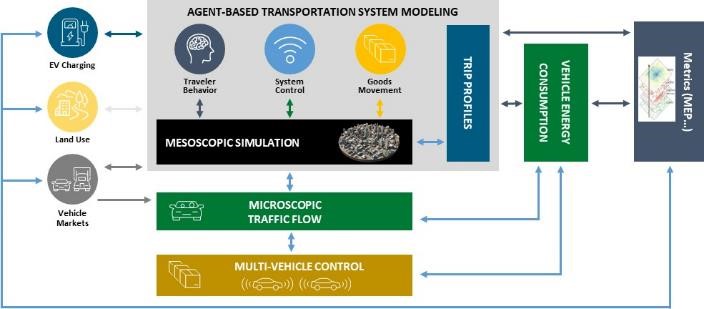SMART Mobility Workflow
Measure the impact of advanced technologies at the transportation system level on mobility, energy, cost and more.
Research on ways to decarbonize the transportation system has traditionally emphasized the importance of vehicles and vehicle components. Today, however, dramatic changes in transportation and communication technologies—from vehicle electrification and automation to shared mobility, e-commerce, and telecommuting—are disrupting the transportation system and escalating the need to understand the systemic energy impacts of human behaviors within the context of so many new choices.
The U.S. Department of Energy (DOE) Systems and Modeling for Accelerated Research in Transportation (SMART) Mobility Consortium is a multi-year, multi-laboratory collaborative dedicated to further understanding the energy implications and opportunities of advanced mobility technologies and services. The SMART Mobility workflow has been developed to evaluate new transportation technologies, such as connectivity, automation, ride-hailing, and electrification, through multi-level systems analysis that captures the dynamic interactions between these technologies. By integrating multiple models across different levels of fidelity and scale, from individual vehicles to entire metropolitan areas, the workflow yields insights about the influence of new mobility and vehicle technologies at the system level.
 SMART Mobility Workflow
SMART Mobility Workflow
Implementation of the workflow by the Argonne National Laboratory Vehicle & Mobility Systems Group (VMS) includes multiple tools:
- POLARIS: an agent-based, mesoscopic transportation system simulation tool used to generate travel demand and traffic flow at the metropolitan area level;
- Aimsun: a traffic microsimulation tool used to generate traffic flow fundamental diagrams, such as the relationships between the speed, flow rate, and density of vehicles on a given transportation link, for different market penetrations of automated vehicles—can be used as an input to POLARIS;
- RoadRunner: a multi-vehicle simulation tool used to estimate the impact of new control algorithms at the vehicle and component levels, enabled by connectivity and automation using Autonomie (see below) powertrain models and vehicle aerodynamic data;
- UrbanSim: a microsimulation platform for forecasting the growth and development of metropolitan regions over decades-scale time horizons, including changes to land use, demographics, and employment. Outputs can be provided to POLARIS for scenario runs;
- Electric Vehicle Infrastructure Projection (EVI-Pro): a tool used to determine public charging station location and type based on plug-in electric vehicle (PEV) trip demand generated by POLARIS;
- Stochastic Vehicle Trip Profile (SVTrip): a tool to synthesize vehicle speed dynamics (e.g., acceleration and deceleration) from detailed POLARIS information (e.g., average vehicle speed per link, road type, and potential stop duration) for use in Autonomie to properly estimate vehicle energy consumption;
- Autonomie: A high-fidelity vehicle simulation tool used to estimate vehicle energy consumption from SVTrip speed traces across vehicle classes, powertrains, and component technologies; and
- MEP: A computation using outputs from UrbanSim, POLARIS, and Autonomie in an aggregate calculation that includes the energy, time, and cost of mobility.
The combination of tools in the SMART Mobility workflow enables the analysis of complex future mobility and vehicle technology scenarios. Collectively, they help characterize the impacts of those scenarios in fine-grained detail over multiple metrics of interest including congestion, economic impact, accessibility, mobility, emissions, energy use and productivity.